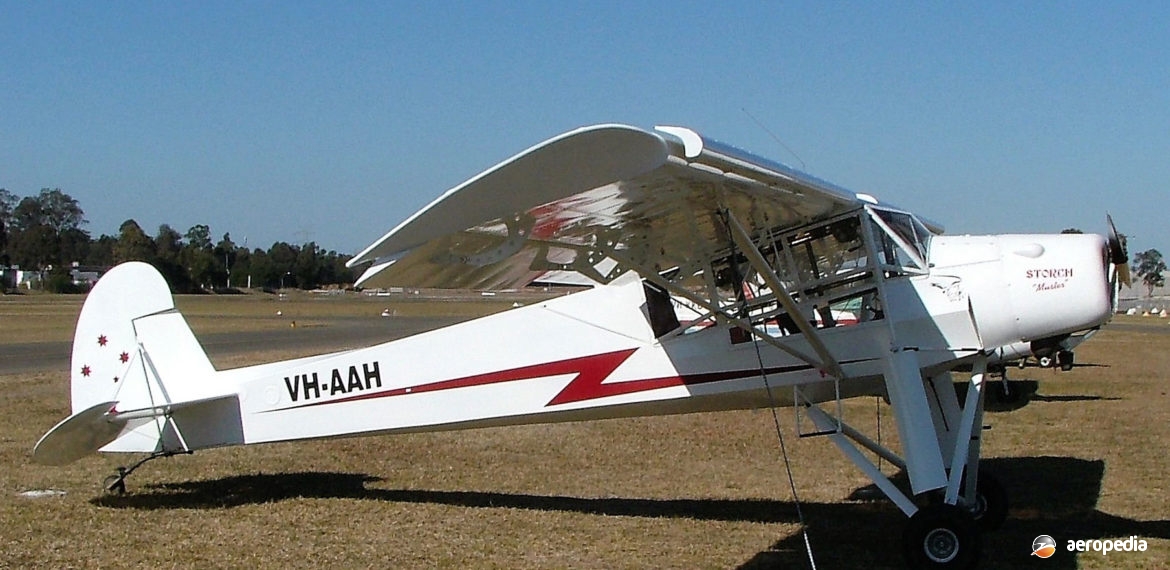Photograph:
Slepcev Storch SS Mk 4 VH-AAH (c/n 089) at Hoxton Park, NSW in July 2005 (David C Eyre)
Country of origin:
Australia
Description:
Two-seat light STOL sport aircraft
Power Plant:
(SS-4)
One 75 kw (100 hp) Rotax 912S four-cylinder four-stroke horizontally-opposed liquid-and-air-cooled engine
Specifications:
- Wingspan: 10 m (32 ft 8 in)
- Length: 6.8 m (22 ft 3 in)
- Height: 2.28 m (7 ft 5 in)
- Wing area: 16 m² (172.2 sq ft)
- Max speed: 157 km/h (98 mph)
- Cruising speed: 130 km/h (81 mph)
- Stalling speed: 35 km/h (22 mph)
- Rate of climb: 183 m/min (600 ft/min)
- Take-off and landing run: 15 to 30 m (50 to 100 ft)
- Service ceiling: 4,572 m (15,000 ft)
- Range: 402 km (250 miles)
- Fuel capacity: 75 litres (16.48 Imp gals)
- Empty weight: 346 kg (763 lb)
- Loaded weight: 550 kg (1,212 lb)
History
Designed and developed by Nestor Slepcev at Beechwood on the mid-north coast of New South Wales, the Storch was a three/quarter scale replica of the Luftwaffe Fieseler Fi 156 Storch STOL communications aircraft. Rotax engines in the 60 kw (80 hp) to 90 kw (120 hp) class, ie the Rotax 618, 912S or the turbocharged 914, have been fitted in the development of the SS.4 model. All aircraft were fitted with dual controls and two seats in tandem, with the exception of the initial first two aircraft, which were both single seaters. In addition, a couple of aircraft have been fitted with the Australian designed and built Rotec R-2800 82 kw (110 hp) seven-cylinder radial engine, to make them similar in appearance to the French-built Storch aircraft with a radial engine. These have became known as the Storch Criquet. One became VH-UFQ, and others have been registered under the RAA category.
The Storch has become popular amongst World War II replica aircraft builders, and a number have been used by flying clubs, for mustering, and for pleasure flying. Examples have been exported to more than 20 countries worldwide, with more than 150 examples delivered. Countries to which it has been exported include Africa, Alaska, Austria, Belgium, Brazil, Canada, England, France, Germany, Italy, Mexico, New Caledonia, Panama, Re-Union Island, Spain, Switzerland, Taiwan, the United States, and Zimbabwe. Certification to JAR-VLA standards, Type Certificate VA505, was received on 14 October 1999. The type in microlight form was available with Lotus floats and all models complied with Swiss noise standards.
The prototype, a single-seater, was first flown in 1991 powered by a 56 kw (75 hp) Rotax 618 engine. Subsequently the two-seat variant was developed and flown in 1994. It was available in kit form, or as a complete aircraft, and was constructed of welded steel tubing with fabric covering. In the United States it was marketed as the Preceptor Storch Replica by Preceptor Aircraft Corp of Hendersonville, North Carolina.
The Storch proved quite popular due to its excellent handling characteristics and STOL ability. A number have been registered in Australia and New Zealand, the first in the latter country becoming ZK-JPH. In more recent times a further variant known as the Super Storch, and the Slepcev Storch Moose fitted with a Vedeneyev radial engine have been developed and made available in kit form.
Nestor Slepcev came from Yugoslavia and designed a number of aircraft to meet Australian category 95-10. These have included the Storch, dealt with here; a three-quarter scale Messerschmitt Bf 109-G2 fitted with a Rotax 582 engine; a single-seat ultralight monoplane built and flown in 2003 but which crashed and was destroyed near Beechwood, NSW on 26 December 2002; and the Yugo, a high-wing light aircraft fitted with two KFM engines.
On 25 August 1996, almost 53 years to the day since Benito Mussolini was rescued from the Ampo Imperator Resort 3,048 m (10,000 ft) above sea level on the Gran Sasso Mountain by German troops with a Fieseler Fi 156 Storch, Mr Slepcev performed a re-enactment of the landing and take-off by landing one of his own aircraft, a Storch fitted with a Rotax 912 engine, at the resort, the landing area being of rough gravel some 70 m (230 ft) in length.
In 2005, after delivering 150 Storchs from the Australian plant, the Company moved offshore, production re-commencing in Serbia, where labour costs were significantly lower.

